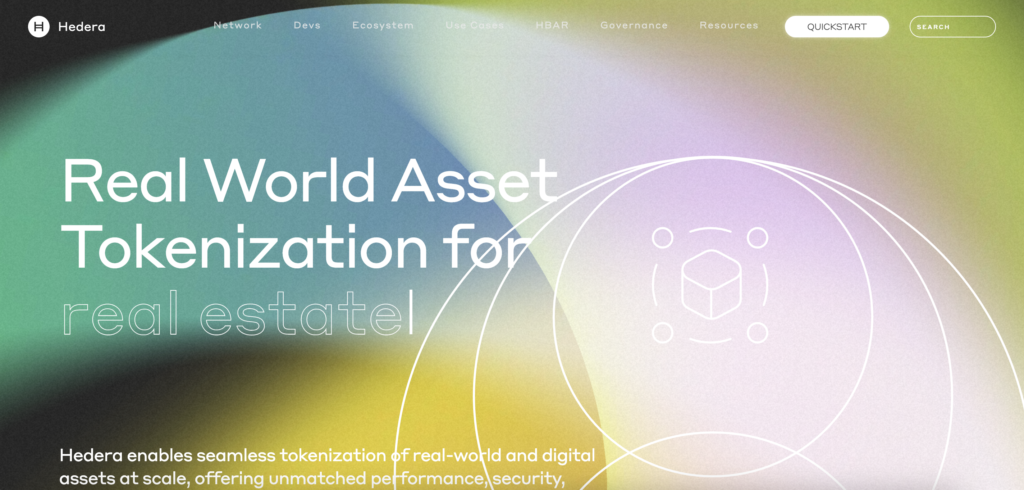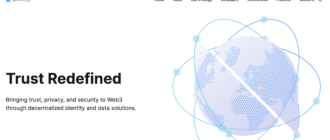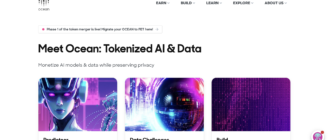This article delves into Hedera, a groundbreaking project in the realm of distributed ledger technologies, and its native cryptocurrency, HBAR. We will explore various facets of Hedera, including its unique consensus algorithm, the role and functionality of HBAR, and the broader ecosystem it supports. Additionally, we will examine the project’s historical development, technological innovations, tokenomics, and future growth prospects.

What is Hedera?
Hedera is a decentralized, open-source public ledger that utilizes a unique consensus mechanism known as the hashgraph algorithm. Unlike traditional blockchain technologies, Hedera’s hashgraph consensus ensures high throughput, fast finality, and low, predictable transaction fees. The platform is designed to enable developers to create scalable and secure decentralized applications (dApps) and ecosystems. Hedera supports a wide range of use cases, including tokenization, decentralized identity, real-time payments, and supply chain management, by providing performance-optimized Ethereum Virtual Machine (EVM) smart contracts and native tokenization services. Governed by a diverse council of leading global enterprises, universities, and web3 projects, Hedera aims to offer a robust, fair, and secure foundation for the next generation of digital solutions.
History of the Project
Hedera was established to address the limitations of traditional blockchain platforms, such as scalability, speed, and security. The project began its journey in 2018, introducing the revolutionary hashgraph consensus algorithm, which offers asynchronous Byzantine Fault Tolerance (aBFT), ensuring the highest level of security. Key milestones in Hedera’s development include the launch of its mainnet in 2019, enabling public access to its high-performance ledger and services. Over the years, Hedera has formed strategic partnerships and onboarded prestigious organizations into its governing council, enhancing its decentralization and resilience. The introduction of the HBAR Foundation in 2021 further accelerated ecosystem growth by providing grants and resources to developers and businesses building on the Hedera network. Through continuous innovation and strategic collaborations, Hedera has established itself as a leader in the decentralized technology space, pushing the boundaries of what is possible with distributed ledgers.
How Hedera Works
Hedera operates on a distinctive technological foundation centered around the hashgraph consensus algorithm. This algorithm differentiates Hedera from traditional blockchain technologies by providing asynchronous Byzantine Fault Tolerance (aBFT), which ensures both high security and fairness in transaction ordering. The hashgraph mechanism allows the network to achieve high throughput and low latency, processing thousands of transactions per second with finality in mere seconds.
Hashgraph Consensus Algorithm
The hashgraph consensus algorithm is the core innovation behind Hedera’s performance. Unlike blockchain’s linear data structure, hashgraph uses a directed acyclic graph (DAG) where each node communicates its information (or “gossip”) about transactions to randomly chosen neighbors. This “gossip about gossip” technique propagates transaction data efficiently across the network. Nodes then use the virtual voting algorithm to achieve consensus on the transaction order, ensuring that the system remains fair and resistant to malicious attacks. The aBFT property of hashgraph guarantees that consensus can be reached even if some nodes act maliciously, making Hedera highly secure and reliable.
Technological Components
- Performance-Optimized EVM Smart Contracts:
Hedera supports Ethereum Virtual Machine (EVM) smart contracts, allowing developers to deploy decentralized applications with familiar tools and languages. These smart contracts benefit from the underlying hashgraph’s speed and security, making them more efficient than those on traditional blockchains. - Hedera Token Service (HTS):
The Hedera Token Service enables the creation and management of native fungible and non-fungible tokens. HTS is integrated directly into the network, ensuring tokens benefit from the same high throughput, low fees, and security features as HBAR transactions. - Hedera Consensus Service (HCS):
HCS allows applications to log messages to the Hedera network for ordering and timestamping. This service is crucial for applications requiring verifiable and immutable logs, such as supply chain tracking and decentralized identity management.
Differentiation from Other Projects
Hedera’s unique consensus mechanism and its governance model set it apart from other distributed ledger technologies. Unlike blockchain-based platforms that rely on proof-of-work (PoW) or proof-of-stake (PoS) mechanisms, Hedera’s hashgraph does not require energy-intensive mining processes, making it more environmentally friendly. The network is governed by the Hedera Governing Council, composed of leading global organizations that ensure decentralized and transparent decision-making.
Technical Details
- Throughput: Hedera can handle over 10,000 transactions per second (TPS), significantly higher than Bitcoin’s 7 TPS or Ethereum’s 30 TPS.
- Latency: Transactions achieve finality in 3-5 seconds, allowing for near-instantaneous confirmation.
- Energy Efficiency: The hashgraph algorithm is lightweight, consuming a fraction of the energy used by PoW blockchains.
In essence, Hedera combines the strengths of advanced cryptographic principles and efficient network design to provide a scalable, secure, and environmentally sustainable platform for decentralized applications.
Tokenomics of Hedera
HBAR, the native cryptocurrency of the Hedera network, functions as a utility token integral to the platform’s operations. Unlike coins such as Bitcoin, which are primarily used as a store of value or medium of exchange, HBAR serves multiple purposes within the Hedera ecosystem, making it a versatile utility token.
Token vs. Coin
HBAR is classified as a token because it operates within the Hedera ecosystem to facilitate various network functions, rather than existing as an independent digital currency. It is designed to power the network services, pay for transaction fees, and provide security through staking.
Emission Model
HBAR has a fixed total supply of 50 billion tokens, with distribution controlled by the Hedera Governing Council to ensure long-term network stability and security. The emission model is carefully managed to support network growth and incentivize participants:
- Initial Distribution: A portion of HBAR was distributed during the initial coin offering (ICO) and subsequent network launches.
- Treasury: A significant amount of HBAR is held in reserve by the Hedera Treasury to support future network developments, ecosystem grants, and strategic initiatives.
- Staking Rewards: HBAR is used to reward network participants who stake their tokens to secure the network, ensuring decentralization and security.
Use Cases and Utility
HBAR serves several key functions within the Hedera network:
- Transaction Fees: HBAR is used to pay for transaction processing fees, ensuring the smooth operation of dApps and other network services.
- Network Security: Token holders can stake HBAR to nodes, participating in the proof-of-stake consensus mechanism, which secures the network and validates transactions.
- Governance: HBAR also plays a role in the decentralized governance model, where staked tokens help influence decisions about network upgrades and policies.
Market Performance
HBAR has experienced varied market performance since its launch, reflecting the broader trends and developments in the cryptocurrency space. Initially priced at $0.12 during the ICO, the token has seen fluctuations driven by market sentiment, technological advancements, and adoption rates.
- Current Price: As of 2024, HBAR trades at a price influenced by its utility and adoption within the Hedera ecosystem.
- Market Cap: The total market capitalization of HBAR reflects its circulation supply and current price, making it a significant player in the cryptocurrency market.
- Trading Volume: HBAR’s trading volume on various exchanges indicates the level of investor interest and liquidity in the market.
Long-Term Prospects
The tokenomics of HBAR are designed to ensure sustainable growth and network security. The Hedera Governing Council’s strategic management of token distribution and incentives aims to foster a robust and resilient ecosystem. As more applications and enterprises adopt Hedera’s technology, the demand for HBAR is expected to increase, potentially driving its value and utility higher.
In conclusion, HBAR is a versatile utility token that underpins the Hedera network’s functionality and security, with a carefully managed emission model and strong use case potential in the decentralized technology landscape.
Where to Buy HBAR
HBAR, the native cryptocurrency of the Hedera network, is available on several major cryptocurrency exchanges. Here is a list of exchanges where you can purchase HBAR:
- Binance: One of the largest and most popular cryptocurrency exchanges in the world, offering a wide range of trading pairs with HBAR, including HBAR/USDT, HBAR/BTC, and HBAR/ETH.
- HTX (formerly Huobi): A major global exchange with comprehensive support for HBAR trading, providing pairs such as HBAR/USDT and HBAR/BTC.
- MEXC: Known for its user-friendly interface and extensive range of cryptocurrencies, MEXC offers HBAR trading with pairs like HBAR/USDT.
- Bybit: A rapidly growing exchange offering HBAR trading options, including perpetual contracts and spot trading.
- KuCoin: Popular for its wide range of cryptocurrencies and advanced trading features, KuCoin supports HBAR/USDT and HBAR/BTC trading pairs.
When choosing an exchange, consider factors such as trading fees, security features, user interface, and available trading pairs to find the best option for your needs.
Where to Store HBAR
Once you have purchased HBAR, it is crucial to store your tokens securely. Here are some of the best wallets for storing HBAR, each offering different features to suit various needs:
- Ledger Nano S/X: A hardware wallet providing top-tier security by storing your HBAR offline. It supports multiple cryptocurrencies and integrates with the Hedera Wallet.
- Atomic Wallet: A non-custodial wallet offering a user-friendly interface and the ability to manage HBAR alongside other cryptocurrencies. It supports staking, allowing users to earn rewards on their HBAR holdings.
- HashPack Wallet: A dedicated wallet for Hedera, providing seamless access to HBAR and Hedera services. It supports HBAR transactions, staking, and interaction with Hedera dApps.
- Guardarian Wallet: A multi-currency wallet that supports HBAR and offers features like in-app exchange, staking, and secure storage.
- MyHbarWallet: A web-based wallet designed specifically for Hedera, allowing users to store, send, and receive HBAR. It supports hardware wallet integration for added security.
When selecting a wallet, consider the following features:
- Security: Hardware wallets like Ledger Nano S/X offer the highest security, as they store your private keys offline.
- Ease of Use: Wallets like Atomic Wallet and HashPack provide intuitive interfaces, making them suitable for beginners.
- Functionality: Some wallets offer additional features such as staking (e.g., Atomic Wallet) or direct interaction with Hedera dApps (e.g., HashPack Wallet).
Storing your HBAR in a secure and reliable wallet ensures that your assets are protected from potential threats and easily accessible for transactions or staking.
Project Prospects
Hedera’s growth is underpinned by its unique technological advancements, strategic governance model, and a robust ecosystem of partners and clients. The hashgraph consensus algorithm provides unparalleled scalability, security, and efficiency, making Hedera a preferred choice for enterprises and developers seeking to build decentralized applications.
Clients and Partners
Hedera’s clientele and partnerships span various industries, including finance, technology, gaming, and supply chain. Key clients and partners include:
- Google Cloud: Leveraging Hedera’s technology for its distributed ledger solutions.
- IBM: Collaborating on enterprise-grade blockchain applications.
- LG: Using Hedera for transparent supply chain management.
- Ubisoft: Exploring blockchain applications in gaming.
- Avery Dennison: Implementing Hedera for product authentication and tracking.
These partnerships demonstrate Hedera’s appeal to leading global enterprises and its capability to support diverse use cases.
Growth Drivers
- Technological Superiority: Hedera’s hashgraph algorithm provides high throughput, low latency, and robust security, addressing the limitations of traditional blockchain platforms.
- Governance Model: The Hedera Governing Council, comprising top-tier organizations, ensures decentralized and transparent decision-making, enhancing trust and stability.
- Ecosystem Development: Continuous expansion of the Hedera ecosystem, supported by the HBAR Foundation, accelerates the growth of decentralized applications and services.
Development Forecast
Hedera is poised for significant growth in the coming years. The platform’s technical strengths and strategic alliances position it well to capture a larger share of the decentralized technology market. Forecasts suggest increased adoption in sectors such as finance, supply chain, and digital identity management, driven by Hedera’s capability to handle high transaction volumes securely and efficiently.
As more enterprises seek scalable and secure decentralized solutions, Hedera’s market position is expected to strengthen. Innovations in tokenization, decentralized finance (DeFi), and non-fungible tokens (NFTs) further enhance its growth prospects.
Project Ecosystem
Hedera’s ecosystem is a comprehensive network of developers, enterprises, and service providers collaborating to build innovative solutions on the platform. Key components of the ecosystem include:
- Developer Tools: Comprehensive resources and tools for building on Hedera, such as the Hedera SDKs and APIs.
- Ecosystem Services: Services like the Hedera Token Service (HTS) and Hedera Consensus Service (HCS) enable seamless tokenization and consensus operations.
- Governance and Security: A decentralized governance model ensures fair and transparent network management, while staking mechanisms maintain network security.
Key Ecosystem Participants
- The HBAR Foundation: Provides funding and resources to developers and businesses building on Hedera.
- HashPack: A leading wallet provider supporting HBAR and other Hedera-based assets.
- Calaxy: A decentralized social media platform built on Hedera.
- SaucerSwap: A decentralized exchange (DEX) leveraging Hedera’s high throughput and low fees for efficient trading.
Hedera’s growing ecosystem underscores its commitment to fostering innovation and collaboration, ensuring the continuous evolution and expansion of its decentralized platform. As the ecosystem matures, it is expected to drive further adoption and utility of the Hedera network, reinforcing its position as a leader in the decentralized technology space.
Conclusion
In summary, Hedera Hashgraph represents a significant evolution in the landscape of decentralized technologies. Through its innovative consensus mechanism and the strategic deployment of its cryptocurrency, HBAR, Hedera is well-positioned to address the scalability, security, and efficiency challenges that have long plagued traditional blockchain platforms. As we look to the future, the potential applications and ongoing developments within the Hedera ecosystem suggest a promising trajectory for both the platform and its users.






